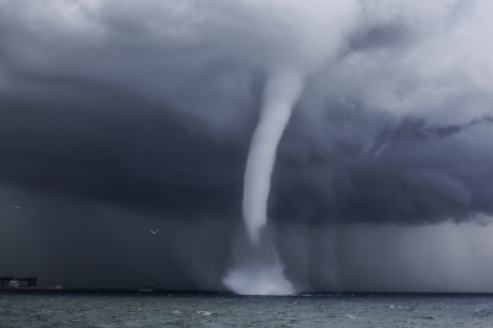Early Friday morning, a rare and dramatic waterspout formed near Koh Khai Nok and Koh Khai Nai, straddling the border between Phuket and Phang Nga provinces. The swirling column of water, generated by a severe thunderstorm, lasted about 10 to 15 minutes and was visible from the shore, leaving many stunned by nature’s raw power.
Fishermen and holidaymakers in the area reported the waterspout moving rapidly across the sea surface. Fortunately, no injuries or significant damage have been reported so far, but officials wasted no time issuing urgent warnings. Both fishing boats and tourists are advised to exercise extreme caution when navigating these waters, as volatile weather conditions could trigger further dangerous storms.
What Is a Waterspout, Anyway?
A waterspout is essentially a tornado that forms over water. It’s a swirling column of air and mist that extends from a cloud down to the sea surface. While they might look terrifying, most waterspouts are less intense than their land-based counterparts. They typically occur when cool air passes over warmer water with high humidity and light winds near the surface, causing a rapid and forceful upward flow of air. This leads to surrounding cooler air rushing in, creating the characteristic twisting vortex often associated with thunderstorms.
In tropical regions like Thailand, waterspouts aren’t uncommon, especially during the monsoon season. They tend to be short-lived but can still pose risks to boats and coastal areas.
Why Should Tourists Care?
If you’re vacationing in southern Thailand, especially around Phuket and Phang Nga, it’s crucial to stay informed about weather conditions. The Meteorological Department has confirmed that unpredictable weather remains a threat across southern Thailand’s coastal areas, with the possibility of more waterspouts and thunderstorms in the coming days. They stressed the importance of staying tuned to continuous weather updates and following official advisories to ensure safety.
Tourists planning boat trips or fishing excursions near the Andaman Sea should remain vigilant and heed warnings from local officials. Keep a close eye on weather reports, avoid unnecessary sea travel during storms, and respect all safety directives issued by local authorities.
Safety Tips for Travelers
-
Stay Updated: Regularly check weather forecasts and heed any advisories from local authorities.
-
Avoid Sea Travel During Storms: If there’s a forecast for thunderstorms or waterspouts, postpone your boat trips.
-
Listen to Local Officials: They have the most accurate and timely information.
-
Be Prepared: If you’re caught in a storm, know the emergency procedures and have a plan in place.
Recent Waterspout Sightings in Thailand
| Date | Location | Duration | Impact |
|---|---|---|---|
| April 11 | Chalong Bay, Phuket | ~45 mins | No damage; viral videos circulated |
| May 30 | Near Koh Khai Nok/Nai | 10-15 mins | No injuries; safety warnings issued |
Conclusion
Nature has its way of reminding us who’s boss. While waterspouts are mesmerizing to watch, they can be dangerous. If you’re in southern Thailand during the monsoon season, stay alert, respect nature’s power, and always prioritize safety.
